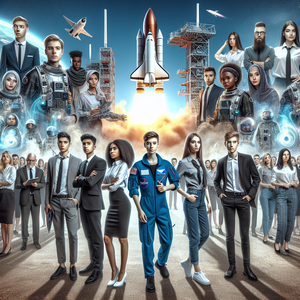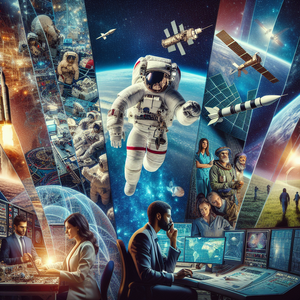From Gamers to Astronauts: Unusual Pathways into the Space Workforce

Historically, a career in space was a narrow path: obtain a degree in aerospace engineering, physics, or astronomy, and rise through the ranks at a government agency or a handful of major contractors. The modern reality, however, is radically different. With the explosion of private space companies like SpaceX and Blue Origin, alongside the continued expansion of NASA and a host of innovative startups, the sector’s talent search has broadened dramatically. Space exploration today is a multidisciplinary venture. It’s not just about building rockets—it's about designing sustainable habitats, developing user-friendly interfaces, analyzing vast datasets, and communicating the wonders of the cosmos to the public. As a result, the space workforce now includes professionals who, just a decade ago, might never have considered their skills relevant to the final frontier.
Why Gamers and Game Designers?
Perhaps the most unexpected recruits to the space workforce are those from the gaming industry. Game designers possess expertise in creating immersive, interactive virtual environments, building physics engines, and perfecting user experience—skills that have become invaluable for astronaut training and mission planning. NASA’s Jet Propulsion Laboratory (JPL) has partnered with Unity, a leading game engine developer, to create interactive tools for mission design. These sophisticated simulations allow teams to virtually rehearse landings on Mars or navigate hazardous terrain, replacing costly and physically limited mockups with flexible digital worlds. Such tools are critical for preparing astronauts and mission controllers for scenarios that are impossible to fully replicate on Earth. Furthermore, the logic, problem-solving abilities, and teamwork fostered in multiplayer gaming environments parallel the demands of mission control. NASA has even hosted "space hackathons," where gamers and programmers tackle real-life challenges such as optimizing satellite orbits or analyzing planetary data.
The Artist’s Touch in the Final Frontier
The need for creativity in space doesn’t stop at engineering. Artists and designers play a vital role in shaping the space experience. As companies like Space Perspective and Virgin Galactic prepare to welcome tourists into orbit, they are hiring interior designers and artists to create aesthetically pleasing and psychologically supportive environments. The psychological effects of color, lighting, and spatial design are crucial in the confined, high-stress quarters of spacecraft—factors that directly impact crew and passenger well-being. Artists also collaborate with scientists to translate complex data into visually accessible graphics. This is essential for both internal analysis and public outreach. For instance, artistic renderings of exoplanet surfaces or Martian soil structures help scientists interpret data and inspire public engagement with space missions.
Biologists, Medical Experts, and Beyond
As missions become longer and more distant—think lunar habitats or Mars colonies—the life sciences have become central to space programs. Biologists are tasked with developing closed-loop life support systems, pioneering space agriculture, and studying how microgravity affects living organisms. Their work is crucial for sustaining human life far from Earth. With extended missions, onboard medical expertise has gone from a luxury to a necessity. Medical professionals are now regular members of astronaut crews, providing remote diagnosis and emergency care. Psychologists are also essential, developing protocols to support mental health in the isolating environment of space. As humanity contemplates colonization and resource extraction on other worlds, ethicists and legal experts are needed to navigate the moral and legal implications of off-world activities.
Why Diversity Matters
The influx of non-traditional talent is not just a matter of filling new job titles—it is a catalyst for innovation. Research consistently shows that diverse teams outperform homogeneous ones in creative problem-solving. This diversity is vital in space, where the unexpected is the norm and where a single oversight can have catastrophic consequences. When NASA’s Perseverance rover faced unexpected rock textures on Mars, a team of geologists, computer scientists, and artists worked together to interpret the data and adapt the rover’s exploration strategy. Their varied perspectives led to new scientific insights and improved operational methods.
The Space Industry’s Hiring Spree
According to recent reports, the global space industry is in the midst of a rapid hiring spree, fueled by satellite internet projects, new lunar missions, and expanding commercial ventures. Over the last six months alone, job postings for rocket engineers, satellite technicians, and project managers have surged. But so have opportunities for simulation developers, designers, biologists, and communicators—illustrating the breadth of talent now needed.
The new space workforce is a tapestry woven from the most unexpected threads. As the industry continues to expand—commercializing low Earth orbit, planning lunar bases, and setting its sights on Mars and beyond—the need for diverse skills and perspectives will only grow. Today’s message is clear: whether you’re a gamer, artist, biologist, psychologist, or engineer, there is a place for you in the cosmos. The future of space exploration belongs to those bold enough to bring their unique talents to the ultimate frontier. In this new era, the question is not whether your skills are traditional enough for space, but whether your imagination is vast enough to help humanity reach for the stars.
Space Mission Simulation Developer
NASA, SpaceX, Lockheed Martin, Blue Origin, KBR, Red 6
Core Responsibilities
Design and implement high-fidelity virtual reality (VR) or game-engine-based simulations for astronaut training, rover operations, and mission rehearsals.
Collaborate with engineers and scientists to translate real-world physics and spacecraft dynamics into interactive digital environments.
Optimize simulations for immersive realism and usability, integrating haptic feedback or multi-user networked experiences.
Required Skills
Advanced proficiency in Unity or Unreal Engine, with strong C# or C++ programming skills.
Background in physics modeling, 3D graphics, or serious game development.
Experience in agile, multidisciplinary teams; strong communication skills to bridge technical and non-technical stakeholders.
Unique Qualifications
Experience in the gaming industry or professional VR/AR content creation is highly valued.
Space Habitat Interior Designer
Axiom Space, Space Perspective, Virgin Galactic, Sierra Space, NASA’s Human Factors teams
Core Responsibilities
Design functional and psychologically supportive interiors for spacecraft, space stations, and surface habitats (e.g., on the Moon or Mars).
Develop solutions for microgravity living, including modular furnishings, lighting schemes, and space-saving layouts.
Incorporate research on circadian rhythms, color psychology, and sensory deprivation into design choices.
Required Skills
Degree in interior design, architecture, or industrial design with expertise in confined/remote environments.
Familiarity with CAD software (e.g., Rhino, SolidWorks), 3D visualization, and human factors engineering.
Ability to collaborate across disciplines (engineers, psychologists, astronauts).
Unique Qualifications
Experience designing for submarines, Antarctic bases, or similar extreme environments is a significant asset.
Space Agriculture Specialist
NASA, ESA, SpaceX, Blue Origin, Redwire Space, Orbital Farm
Core Responsibilities
Develop and maintain controlled-environment agricultural systems (hydroponics, aeroponics) for food production on spacecraft or planetary habitats.
Conduct experiments on plant growth under microgravity and radiation conditions, analyzing genetic and nutritional outcomes.
Integrate biological life support systems with habitat engineering (e.g., oxygen regeneration, waste recycling).
Required Skills
Advanced degree in botany, plant biology, or bioengineering; hands-on experience with greenhouse or vertical farming tech.
Familiarity with life support system integration and environmental monitoring sensors.
Unique Qualifications
Previous research or operational work in closed-loop biospheres or space analog habitats (e.g., HI-SEAS, Biosphere 2) is highly prized.
Space Data Visualization Specialist
NASA, Jet Propulsion Laboratory, Planet Labs, Maxar Technologies, public science organizations
Core Responsibilities
Translate complex scientific datasets (e.g., planetary imagery, sensor telemetry, simulation outputs) into clear, compelling visual formats for both expert analysis and public outreach.
Collaborate with scientists, engineers, and communicators to ensure accuracy and accessibility of visuals.
Design interactive dashboards, infographics, and 3D renderings for mission planning, anomaly detection, or storytelling.
Required Skills
Proficiency in data visualization tools (D3.js, Tableau), graphic design software (Adobe Creative Suite), and scientific programming (Python, MATLAB).
Strong artistic sensibility combined with scientific literacy; ability to convey nuanced information visually.
Unique Qualifications
Portfolio demonstrating work with large-scale scientific or geospatial data; experience in space or earth sciences is a bonus.
Spaceflight Medical Officer
NASA, SpaceX, Axiom Space, European Space Agency, commercial spaceflight providers
Core Responsibilities
Serve as the primary healthcare provider for astronaut crews, both during training and on space missions.
Develop and implement medical protocols for telemedicine, emergency care, and psychological support in microgravity and isolated environments.
Conduct research on the physiological effects of spaceflight (bone loss, radiation exposure, immune response) and contribute to countermeasure development.
Required Skills
Medical degree (MD or DO) with board certification in emergency, internal, or aerospace medicine.
Experience with telehealth technologies and crisis management; advanced training in space medicine is highly desirable.
Unique Qualifications
Prior flight surgeon experience, military medical background, or research in extreme/remote medicine environments (e.g., Antarctic stations, submarines) is a plus.


